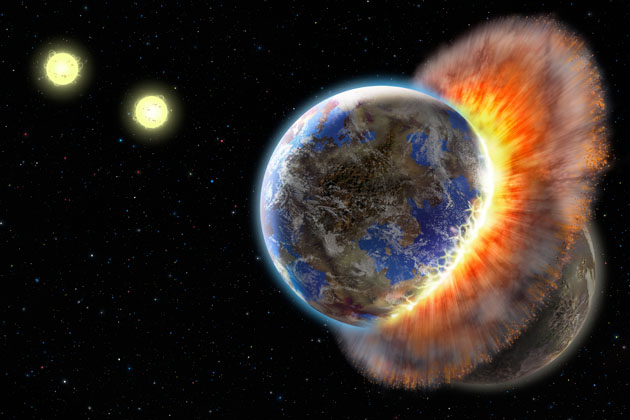Two terrestrial planets in orbit around a sun-like star, BD +20 307, recently suffered a violent collision, astronomers at University of California Los Angeles, Tennessee State University, and California Institute of Technology will report in a December issue of the Astrophysical Journal, the premier journal of astronomy and astrophysics.
“It’s as if Earth and Venus collided with each other,” said Benjamin Zuckerman, UCLA professor of physics and astronomy and a co-author on the paper. “Astronomers have never seen anything like this before; apparently major, catastrophic, collisions can take place in a fully mature planetary system.”

“If any life was present on either planet, the massive collision would have wiped out everything in a matter of minutes: the ultimate extinction event,” said coauthor Gregory Henry, an astronomer at Tennessee State University. “A massive disk of infrared-emitting dust circling the star provides silent testimony to this sad fate,” said Henry.
Zuckerman, Henry, and Michael Muno (a former Caltech astronomer) were studying a star known as BD +20 307, which is surrounded by a shocking one million times more dust than is orbiting around our sun. The star is located about 300 light-years from Earth in the constellation Aries. The astronomers gathered X-ray data with the orbiting Chandra X-ray Observatory and brightness data from one of TSU’s automated telescopes in southern Arizona, hoping to measure the age of the star.
“We expected to find that BD +20 307 was relatively young, a few hundred million years old at most, with the massive dust ring signaling the final stages in the formation of the star’s planetary system,” said Muno.
However, those expectations were shattered when Carnegie Institution of Washington astronomer Alycia Weinberger announced in the May 20th issue of the Astrophysical Journal that BD +20 307 is a close binary star.
“That discovery radically revised the interpretation of the data and transformed the star into a unique and intriguing system,” said TSU astronomer Francis Fekel who, along with TSU’s Michael Williamson, was asked to provide spectroscopic data from another TSU automated telescope in Arizona to assist in comprehending this exceptional binary system.
The new spectroscopic data confirmed that BD +20 307 is composed of two stars, both very similar in mass, temperature, and size to our own Sun. They orbit about their common center of mass every 3.42 days.
“The patterns of element abundances in the stars show that they are much older than a few hundred million years, as originally thought,” said Fekel. “Instead, the binary system appears to have an age of several billion years, comparable to our solar system.”
“The planetary collision in BD +20 307 was not observed directly but, rather, was inferred from the extraordinary quantity of dust particles that orbit the binary pair at about the same distance as Earth and Venus are from our Sun,” Henry said. “If this dust does indeed point to the presence of terrestrial planets, then this represents the first known example of planets of any mass in orbit around a close binary star.”
Zuckerman and colleagues first reported in the journal Nature in July 2005 that BD +20 307, then still thought to be a single star, is surrounded by more warm orbiting dust than any other sun-like star known to astronomers. The dust is orbiting the binary system in close, where Earth-like planets are most likely to be and where dust typically cannot survive long. Small dust particles get pushed away by stellar radiation, while larger pieces get reduced to dust in collisions within the disk and are then whisked away. Thus, the dust-forming collision near BD +20 307 must have taken place rather recently, probably within the past few hundred thousand years and perhaps much more recently, the astronomers said.
“This poses two very interesting questions,” Fekel said. “How do planetary orbits become destabilized in such an old, mature system? Could such a collision happen in our own solar system?”
"The stability of planetary orbits in our own solar system has been considered for nearly two decades by astronomer Jacques Laskar in France and, more recently, by Konstantin Batygin and Greg Laughlin in the USA," Henry noted. "Their computer models predict planetary motions into the distant future and they find a small probability for collisions of Mercury with Earth or Venus sometime in the next billion years or more. The small probability of this happening is probably related to the rarity of very dusty planetary systems like BD +20 307."
“There is no question, however,” said Zuckerman, “that major collisions have occurred in our solar system’s past. Many astronomers believe our moon was formed from the grazing collision of two planetary embryos — the young Earth and a body about the size of Mars — a crash that created tremendous debris some of which condensed to form the moon, and some of which went into orbit around the young sun. By contrast with the massive crash in the BD +20 307 system, the collision of an asteroid with Earth 65 million years ago, the most favored explanation for the final demise of the dinosaurs, was a mere pipsqueak.”
In their 1932 novel “When Worlds Collide,” science fiction writers Philip Wylie and Edwin Balmer destroyed the Earth by a collision with a planet of a passing star. The 1951 classic movie, based on the novel, began a long line of adventure stories of space-rocks apocalyptically plowing into Earth. “But,” Zuckerman noted, “there is no evidence near BD +20 307 of any such passing star.”
This research is federally funded by the National Science Foundation and NASA and also by Tennessee State University and the State of Tennessee through its Centers of Excellence program. The Astrophysical Journal is published by the American Astronomical Society.
Get a preprint copy of the paper here.





Comments